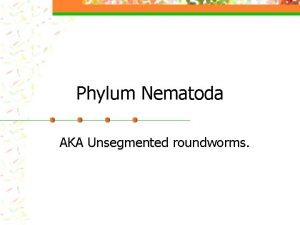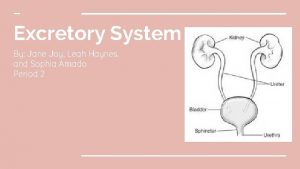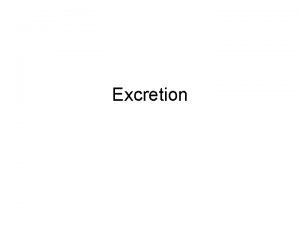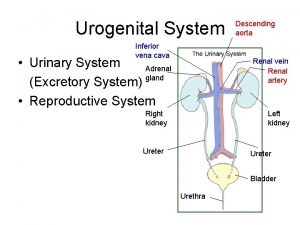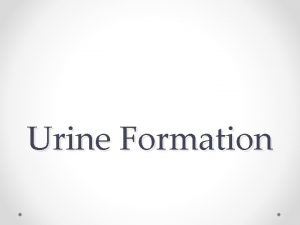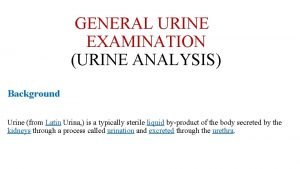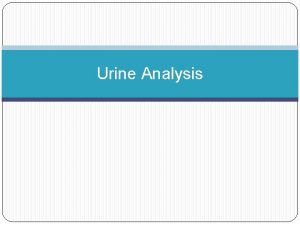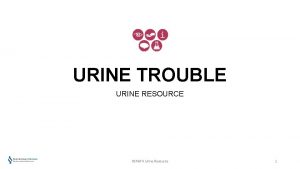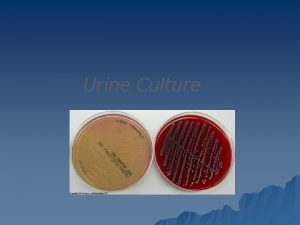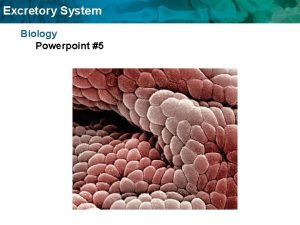Urine formation in Excretory System Chapter 10 1























- Slides: 23

Urine formation in Excretory System Chapter 10. 1 & 10. 2 Mc. Graw-Hill Ryerson Biology 12 (2011)

Simple Excretory Systems • Unicellular organisms get rid of wastes by the use of a contractile vacuole. • It expels excess water that enters the cell through osmosis since the organism is hypertonic to the surrounding solution. http: //dbs. umt. edu/courses/biol 103/labs/Westphal/7 a_osmoregulation_paramecium_files/image 004. jpg

Complex Excretory Systems • More complex organisms (multicellular, or living on land) need to store wastes and use special cells that are in the excretory system to remove wastes from the body.

Organs of the Excretory system • Lungs: gas waste, i. e. CO 2 • Colon: solid wastes from the digestive system • Kidneys: water-soluble waste, as well as regulation of body p. H and water levels.

Processing of Wastes • The liver transforms ingested toxins such as alcohol, heavy metals and waste from protein metabolism into soluble compounds that can be removed by the kidney:

Water soluble wastes • Ammonia: produced by protein metabolism. It is very toxic so the liver converts it to. . . • Urea (100, 000 x less toxic than ammonia) • Uric acid comes from the metabolism of nucleic acids. Less soluble than urea; a build of uric acid can lead to kidney stones.

The Urinary System • Wastes are filtered from blood into the kidneys and sent to the bladder. • Renal arteries pass blood to the kidneys. • Ureters pass urine to the bladder. Be sure you can label this diagram!

The Urinary System • Urinary sphincter controls the release of urine from bladder. • Urethra is the tube used to void the bladder. • 200 m. L of urine bladder expands stretch receptors send a signal to the brain. You choose whether to void (voluntary control over sphincter)…to a point.

Kidney Structure • • • Cortex: outer layer of connective tissue Medulla: inner layer under the cortex renal pelvis: hollow chamber which connects the kidney with the ureter Take a minute to memorize this diagram.

NEPHRON • Nephrons: approximately one million small functional units of the kidney spanning the cortex and the medulla • They are comprised of specialized blood vessels and tubes that wrap around each other for filtering wastes from the blood and producing urine. http: //www. sciencetechnologyaction. com/lessons/8/fig 1. gif

Microscopic Anatomy of the Kidneys § § § Filtration § Filtrate of blood leaves kidney capillaries Reabsorption § Most nutrients, water, and essential ions reclaimed Secretion § Active process of removing undesirable molecules

The mammalian nephron This nephron has been spread out. BLUE= tubes RED = blood vessels

Blood flow in the Nephron • Afferent arterioles supply blood to the kidney from the renal artery. They end in a capillary network or capillary bed called the glomerulus.

Blood flow in the Nephron • Blood exits the glomerulus through efferent arterioles that lead to a network of peritubular capillaries which surround the tubules of the nephron.

Blood flow in the Nephron • They collect into the renal venules and blood exits the kidney through the renal vein.

Fluid Flow in the nephron • The glomerulus is surrounded by the Bowman's capsule. It, along with the afferent and efferent arterioles and the glomerulus are in the cortex of the kidney.

Fluid Flow in the nephron • Fluids that are to be processed as urine enter the Bowman's capsule from the blood in the glomerulus.

Fluid Flow in the Nephron • The Bowman's capsule leads to a thin tubule called the proximal tubule. • Proximal tubule use active transport to bring Na, glucose, and other solutes back into the blood • Negative ions tag along back to blood due to attraction • Water follows the ions by osmosis back into blood

Fluid Flow in the Nephron • Urine goes from the proximal tubule around the loop of Henle, which descends into the medulla of the kidney then ascends to the cortex. • Function is to reabsorb water and ions back to blood • Medulla is very salty so water diffuses by osmosis in descending loop • Ascending loop is impermeable to water so solutes diffuse • Thick segment of ascending limb actively transports Na in blood

Fluid Flow in the Nephron • Urine then moves through the distal tubule • K ions are actively secreted from blood • H+ are actively secreted from blood to maintain blood p. H • Other substances not normally part of body are secreted

Fluid Flow in the Nephron • Urine moves into collecting ducts, which collect urine from many nephrons and lead into the renal pelvis of the kidney. • Filtrate still possesses lots of water • Permeability to water being reabsorbed is increased depending on concentration of blood plasma (i. e. dehydration leads to increased permeability meaning more reabsorbtion)

Identify the structures: C D I K Collecting ducts Bowman’s Capsule B L Proximal tubule Distal tubule A Loop of Henle Glomerulus G Peritubular Capillaries Renal venule H F Renal vein Renal artery E Afferent arteriole J Efferent arteriole You can refer to page 447 of your textbook for help

Homework • Pg 448 #4, 5, 6, 7, 8 • Pg 455 #2 -5, 11, 12 • Be sure to look at Table 10. 3 on pg 454!!
 Dari hasil tes urine ternyata
Dari hasil tes urine ternyata Chapter 20 urinary/excretory system
Chapter 20 urinary/excretory system Physiology of urine formation
Physiology of urine formation Kidney tubular secretion
Kidney tubular secretion Urine formation introduction
Urine formation introduction Urine formation
Urine formation Bile salts in urine
Bile salts in urine The mammalian excretory system
The mammalian excretory system Unsegmented roundworms
Unsegmented roundworms What does the excretory system do
What does the excretory system do Describe the human excretory system
Describe the human excretory system Nephron def
Nephron def 5 facts about the excretory system
5 facts about the excretory system Jane joy
Jane joy Section 38-3 the excretory system
Section 38-3 the excretory system Earthworm excretory system
Earthworm excretory system Questions on digestive system
Questions on digestive system Mammary papilla pig
Mammary papilla pig 5 facts about the excretory system
5 facts about the excretory system Birds classification
Birds classification External structure of silkworm
External structure of silkworm Process of excretion
Process of excretion Excretory system quizizz
Excretory system quizizz Urogenital system
Urogenital system








